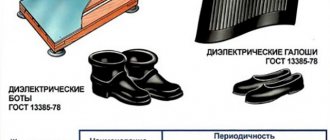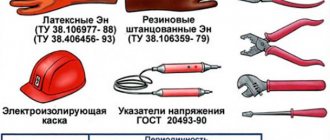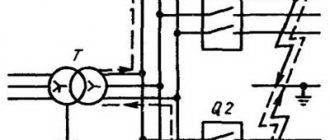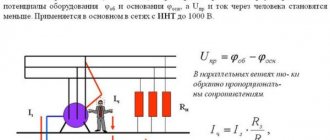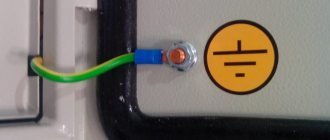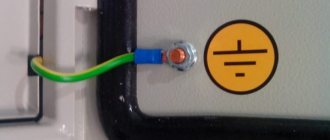Date added: 2015-04-21; ; Copyright infringement
First, let's expand on the concepts used in defining direct and indirect touch.
A conductive part is a part that can conduct electric current.
Current-carrying part is a conductive part of an electrical installation that is under operating voltage during its operation, including the neutral working conductor (but not the PEN conductor).
An exposed conductive part is a conductive part of an electrical installation that is accessible to touch and is not normally energized, but which may become energized if the main insulation is damaged.
Third-party conductive part – a conductive part that is not part of the electrical installation.
Direct touch is electrical contact of people or animals with live parts.
Measures to protect against direct contact:
- Basic insulation of live parts , which must cover them completely and withstand all possible impacts to which it may be exposed during operation. In the case where basic insulation is provided by an air gap, protection from direct contact with live parts or approaching them at a dangerous distance, including in electrical installations with voltages above 1 kV, must be provided by means of shells, fences, barriers or placement out of reach .
- Fences and shells that in electrical installations with voltages up to 1 kV have a degree of protection of at least IP 2X - except for cases where large gaps are necessary for the normal operation of electrical equipment. Guards and shells must be securely fastened and have sufficient mechanical strength. Entering the fence or opening the shell should be possible only with the help of a special key or tool or after removing the voltage from live parts. If these conditions cannot be met, intermediate barriers with a degree of protection of at least IP 2X must be installed, the removal of which must also be possible only with the help of a special key or tool.
- Barriers designed to protect against accidental contact with live parts in electrical installations with voltages up to 1 kV or from approaching them at a dangerous distance in electrical installations with voltages above 1 kV. Removal of barriers does not require the use of a wrench or tool, but they must be secured so that they cannot be removed inadvertently. Barriers must be made of insulating material.
- Placement out of reach to protect against direct contact with live parts in electrical installations with voltages up to 1 kV or approaching them at a dangerous distance in electrical installations with voltages above 1 kV. In this case, the distance between conductive parts accessible to simultaneous touch in electrical installations with voltages up to 1 kV must be at least 2.5 m. Within the reach zone there should be no parts that have different potentials and are accessible to simultaneous touch. In the vertical direction, the reach zone in electrical installations with voltages up to 1 kV should be 2.5 m from the surface on which people are located. The indicated dimensions do not take into account the use of auxiliary equipment (for example, tools, ladders, long objects).
- The use of ultra-low (small) voltage in electrical installations with voltages up to 1 kV in combination with protective electrical separation of circuits or in combination with automatic power off.
Indirect touch is electrical contact of people or animals with exposed conductive parts that become energized when the insulation is damaged.
Measures to protect against indirect contact (individually or in combination):
- Protective grounding;
- Automatic power off;
- Potential equalization (electrical connection of conductive parts to achieve equality of their potentials);
- Potential equalization (reducing the potential difference (step voltage) on the surface of the earth or floor using protective conductors laid in the ground, in the floor or on their surface and connected to a grounding device, or by using special earth coverings);
- Double or reinforced insulation;
- Ultra-low (low) voltage;
- Protective electrical separation of circuits;
- Insulating (non-conductive) rooms, zones, areas.
Potential equalization is the electrical connection of conductive parts to achieve equality of their potentials.
The main potential equalization system in electrical installations up to 1 kV must connect the following conductive parts:
- Zero protective PE or PEN conductor supplying lines in a TN system;
- Grounding conductor connected to the grounding device of an electrical installation in IT and TT systems;
- A grounding conductor connected to the re-grounding electrode at the entrance to the building (if there is a ground electrode);
- Metal pipes of communications entering the building: hot and cold water supply, sewerage, heating, gas supply, etc.
- If the gas supply pipeline has an insulating insert at the entrance to the building, only that part of the pipeline that is located relative to the insulating insert on the side of the building is connected to the main potential equalization system;
- metal parts of the building frame;
- metal parts of centralized ventilation and air conditioning systems. If there are decentralized ventilation and air conditioning systems, metal air ducts should be connected to the PE bus of the power supply panels for fans and air conditioners;
- grounding device of the lightning protection system of the 2nd and 3rd categories;
- grounding conductor of functional (working) grounding, if there is one and there are no restrictions on connecting the working grounding network to the protective grounding device;
- metal sheaths of telecommunication cables.
- Conductive parts entering the building from the outside must be connected as close as possible to the point of their entry into the building.
- To connect to the main potential equalization system, all specified parts must be connected to the main ground bus using the potential equalization system conductors.
Connection diagram of conductive parts in the building to the main potential equalization system:
Date added: 2016-12-06; | Copyright infringement
AgoIn one of the previous articles, we already talked about the danger of direct contact with live elements and the technical protective measures used to prevent accidental contact. This article will discuss the danger posed by indirect touch. The collected materials will make it possible to understand how it differs from direct contact and how undesirable consequences can be eliminated.
Protection against direct contact
To protect a person from direct contact, there are two main protective measures.
1. The first one is quite logical. To protect a living being from touching live parts, it is necessary, but not sufficient, to physically cover those live parts. For example, electrical wires are protected with insulation, exposed live parts are fenced, etc. 2. Second protection, additional from direct contact. It must protect a person who has already touched a live part. This protection is based on the use of a residual current device (RCD) in the electrical network, with a short response time and high sensitivity (no more than 30 mA).
Indirect touch
Indirect touch is inherently more dangerous than direct touch. If a direct touch is more likely an accident caused by an oversight, then an indirect touch occurs in an emergency situation and the person does not know in advance that this or that structure is energized.
To protect against indirect contact, also known as short circuit protection, more diverse methods are used. There are several main ones.
Basic protection:
- Automatic power supply shutdown;
Special protection:
- Application of potential equalization schemes;
- Separation of electrical circuits in a room using isolation transformers;
- Application of a safety extra-low voltage (SELV) system;
- Use of a grounded safety extra-low voltage (SELV) system.
It is necessary to remember: The maximum value of touch voltage Uc that a person can withstand indefinitely is 50 Volts AC.
Each method of short circuit protection differs in its organization for different electrical networks. For power supply systems with a solidly grounded neutral (TN system), with an isolated neutral (IT system), with grounding of electrical installation housings independent of the neutral (TT system), short circuit protection is done according to its own circuits and principles.
At the end of the article I want to note. It must be remembered that, despite the absence of odor and external manifestations, electric current is vitally dangerous for humans in any interaction. Only comprehensive protection of the electrical network can serve as a guarantee against any human contact with live parts and electric shock. That's all!
©Elesant.ru
Other articles in the section: Electrical networks
- Automatic circuit breakers
- Types of power transmission line supports by material
- Types of supports by purpose
- Overhead power lines with SIP wires
- Wooden supports for overhead power lines
- Reinforced concrete power transmission line supports
- Reinforced concrete power transmission line supports
- Protection of humans from electric shock, direct and indirect contact
- How does a 380 Volt low voltage consumer receive electricity?
- Cable network wells installation stages
Insulation as protection against direct contact
Insulation of electrical wires, as well as their connections, is the main method of protection. All wires and cables that are used in electrical installations and are accessible to touch must have electrical sheaths (insulation) in accordance with regulatory documents.
For example, a three-core cable of the VVG brand has polyvinyl chloride core insulation and general cable insulation made of the same material.
Another example, power transmission wires mounted on poles (inaccessible for touching) may not have insulation (AB wires).
Protection measures
Considering that the threat of contact is accidental, special measures are required to minimize the danger posed by electrical contact with third-party conductive elements that contain dangerous potential. The list of special measures is specified in GOSTs 50571.1-93 and 30331.1-95, we list what the regulatory documents offer:
- Organization of grounding at the site.
- Installation of an RCD at the input that responds to leakage current.
- Produce a potential level close in value.
- In critical places accessible to touch, additional (double) insulation is installed on current-carrying elements.
- Use of low voltage installations.
- Use of transformers for galvanic isolation.
- Creation of isolating zones.
Let us consider in more detail each of the listed protection measures.
Grounding
In this case, we are talking not about functional, but about protective grounding. That is, conductive surfaces of equipment that pose a potential danger are connected to the charger. If the insulation resistance becomes lower than permissible, and as a result, phase voltage is formed on the housing. By touching such an installation body, a person standing on the ground will be exposed to dangerous voltage equal to the potential of a single-phase current.
When all open conductive surfaces that pose a possible threat are connected to the charger, the situation described above will not occur, since the contact point will be at zero potential.
Indirect contact between ungrounded and grounded housings
As you can see, the nature of the effect of electrical touch is determined by the resistance of the circuit. In the first case, touching a conductive element leads to the passage of electric current through the human body. In the second, the grounding resistance is much lower than that of the human body, so the leakage occurs through the charger.
The use of grounding conductors should not be considered as a panacea; in some cases, additional requirements may preclude the use of a charger.
Auto power off
With this method, the phase (phases) and zero at the power input are opened, that is, they are turned off simultaneously. The term “automatic” implies that operation occurs without human intervention. The automatic shutdown system (AO) can be used in conjunction with grounding or independently of it. The protection response speed is calculated in tenths of a second, which meets the requirements of electrical safety standards.
This method is widely used in production, for example, on lines that power hand-held power tools, mobile installations, etc. In everyday life, through protective shutdown devices, power is supplied to storage water electric heaters, dishwashers and washing machines, as well as other equipment.
You can familiarize yourself with the operating principle and description of the main characteristics of the RCD in earlier publications on our website.
Potential equalization
This term refers to the connection of all open conductive structural elements and equipment to a protective grounding bus with zero potential to ensure electrical safety. A verbatim description of the term can be found in the PUE (see clause 1.7.32).
Let's give an example: let's say that in a production workshop, the housings of several machines are connected to their own chargers, while the rest of the equipment is grounded to the PE bus. As a result of such illiterate grounding during a short circuit to the frame, a potential difference is formed between the open current-carrying elements of grounded and neutralized equipment, which will create a serious threat to life.
That is why the requirement for potential equalization is put forward, which is fulfilled by connecting open conductive surfaces to the PE bus. This eliminates the danger of touching conductive elements.
Potential equalization
According to the definition in the PUE (see clause 1.7.33), equalization should be understood as a decrease in the potential difference on a conductive coating. That is, in fact, we are talking about reducing the impact factor produced by the step voltage. As a special measure, conductors are installed that are connected to the common memory via the PE bus. Instead, a grounded conductive floor covering may be used.
Double or reinforced insulation
Almost any equipment powered from a network up to 1.0 kV can be equipped with double or reinforced insulation coating (in addition to the main one used to cover current conductors). With this design, if a decrease in resistance occurs as a result of damage to the main insulation, an additional dielectric will prevent contact with the conductive surface. Accordingly, if there are problems with additional insulation, the main insulating layer will act. The probability of simultaneous destruction of two layers is extremely small.
Double and reinforced insulation may be used as the primary protection against indirect contact. That is, without using other protective measures.
Low (ultra-low) voltage
This method can be called a universal electrical safety measure; accordingly, it also works with indirect touch. The transformer used to step down the voltage also plays the role of galvanic isolation. For DC networks, the value of extra-low voltage is set to 60.0 V, variable power supplies - 25.0 V.
This type of protection can be used as the only electrical safety measure to eliminate the risk of contact.
Electrical separation of circuits
In this case, we are talking about galvanic isolation, thanks to which it is possible to transfer electricity from one circuit to another in the absence of a direct electrical connection. Examples of electrical circuit separation are given below.
Example of galvanic isolation using a transformer (1) and a diode optocoupler (2)
As you can see, in the first case, galvanic isolation is carried out using a transformer, in the second - a diode optocoupler.
If electrical separation is abandoned, the amount of current flowing from one circuit to another will be limited by their internal resistance. Moreover, the amount of resistance will be insignificant. Equalizing currents generated by internal processes, especially in long-distance circuits, pose a serious threat when touched.
Isolating rooms, zones
This method is effective even without a protective ground. Reliable insulation of walls and floors provides protection against direct and indirect single-pole contact. The lower limit of the room insulation resistance, for electrical installations with voltages up to 1.0 kV, should not fall below 100.0 kOhm. For equipment powered from an electrical network with a voltage of no more than 0.5 kV, the resistance providing protection is set within 50.0 kOhm.
Combination of methods and additional measures.
For the most part, the protection methods listed above can be used together. But sometimes this is unacceptable, for example, installing protective conductors connected to the charger in the insulation zone will lead to a violation of equal potentials. The above example is rather an exception, but it once again indicates that caution must be exercised when choosing from among the additional protective measures available for simultaneous use.
Similar materials on the site:
Protection by fences and shells
This protective measure is familiar to everyone. All transformer substations, open electrical installations, electrical panels must be fenced off with fences, doors, and equipped rooms.
In addition, for the installation of all switching and protective devices of electrical circuits, so-called shells must be installed, or more simply shields, cabinets, boxes with doors.
Related articles: AC electromagnets
In this case, the doors of the enclosures must be locked, and an additional screen must be installed between the doors and the live parts themselves.
It is important to note. If the shells are made of metal, they must be grounded together with the electrical installation.
All of the protective measures listed are precautionary, but from experience, they are not sufficiently reliable. There are several reasons for this:
Similar
Direct touch in electrical installations is
VIDEO ON THE TOPIC: Electrical safety Electrician safety Do-it-yourself electrician course part 10
If you could not find the answer to your question on the pages, just ask it. It's fast and absolutely free
!
- Online form: >>
Our clients. Electric installation work. Moscow, Elektrodny proezd, building 8, 5th floor. Our clients further Methods of protection against electric shock and the type of insulation depend on the power of the electrical installation. Enterprises use double insulation to protect against contact with live parts in electrical installations operating at voltages above 1 V.
DBN V.
Basic requirements for organizing the safe operation of electrical installations. Electrical safety in existing electrical installations up to Volts. Manufacturing jobs.
Indirect touch in electrical installations definition
What requirements do the Rules impose on the implementation of basic insulation of live parts? Basic insulation of live parts must cover live parts and withstand all possible impacts to which it may be subjected during operation. Removal of insulation should only be possible by destroying it. Paint and varnish coatings are not insulation that protects against electric shock, except in cases specifically stipulated by the technical specifications for specific products 1.
What degree of protection should fences and shells have in electrical installations with voltages up to 1 kV? Barriers and enclosures must have a degree of protection of at least IP2X, except where large clearances are necessary for normal operation of electrical equipment 1. What type of protection are barriers intended for?
Barriers are designed to protect against accidental touching of live parts in electrical installations with voltages up to 1 kV or approaching them at a dangerous distance in electrical installations with voltages above 1 kV, but do not exclude intentional touching and approaching live parts when bypassing the barrier.
Barriers must be made of insulating material 1. In what cases, to protect against direct contact with live parts in electrical installations up to 1 kV, can placement be used outside the reach or approaching them at a dangerous distance in electrical installations with voltages above 1 kV?
Can be applied if it is impossible to implement the measures specified in the answers to the two previous questions or their insufficiency. There should be no parts within the reach zone that have different potentials and can be touched at the same time. Under what conditions is protection from direct contact required in electrical rooms of electrical installations with voltages up to 1 kV?
Protective measures during terrorist attacks Actions in the event of a sudden explosion Try to calm down and clarify the situation. In a destroyed or damaged room, due to the danger of an explosion of accumulated gases, do not use open flames with matches. General safety measures The larger and more modern the OS, the more various engineering and technical structures it contains.
They constantly require preventive measures, including: Measures of protection against direct and indirect touches Question. SNN c may be applied. Protective measures for indirect contact Question.
Which electrical installation elements are subject to indirect contact protection requirements? Applies to: housings of electrical machines, transformers, apparatus, lamps, etc. Protective safety measures Question. How to carry out protective grounding of metal housings of general lighting lamps with incandescent lamps and fluorescent lamps, DRL, DRI, DRIZ, sodium lamps with ballasts built into the lamp. What protective security measure should be implemented in all premises?
Connection must be made to the HF of general lighting lamps and stationary electrical receivers for electric stoves, boilers, and household ones. How should movable metal structures of the stage, arena, intended for the installation of lighting and power electrical receivers, soffit trusses, portal scenes, etc. be connected to protective grounding?
Installations of direct, indirect and combined ore-thermal and ferroalloy arc furnaces Question. What types of protection should be provided for furnace transformers and transformer units of arc furnace installations? Must be. Installations of direct and indirect resistance furnaces Question.
Where it is allowed to install furnace step-down and regulating dry transformers, autotransformers, as well as transformers with non-flammable liquid and control panels if they do not have instruments. Grounding and protective electrical safety measures Scope.
Terms and definitions Question Which electrical installations are covered by this section of the PUE? Applies to all electrical installations of alternating and direct current up to 1 kV and above. Safety precautions To ensure that the devices recommended in the book serve you for a long time, you must follow the safety instructions. To avoid the risk of fire and electric shock, before turning on electrical devices powered for the first time. Question 1. The main causes of injuries: lack of or insufficient soil support; exceeding the critical height.
Upon acceptance, they check: the condition and compliance of access roads; the presence of external and underground ones. Share on the page. Similar chapters from other books.
Direct and indirect touch. Protection measures
Assess the danger of direct human contact with conductors of three-phase networks with voltages up to V. Study the influence of network parameters of the neutral mode, insulation resistance and capacitance of phase conductors relative to the ground on the risk of electric shock to a person.
Assess the danger of direct human contact with conductors of three-phase networks with insulated and grounded neutrals at various insulation resistances and capacitances of the conductors relative to the ground. Compare the danger for two modes of network operation - normal and emergency, that is, when one phase conductor is shorted to ground and the protective automatic power off fails.
Under normal network operation, determine the current passing through a person when touching a phase conductor depending on:.
Analysis of the danger of touching live parts of the power plant
The main causes of electric shock can be listed as follows:
1) accidental touching or approaching at a dangerous distance to live parts (with damaged insulation or capacitance) that are energized;
2) the appearance of voltage on disconnected live parts where people are working due to the installation being turned on by mistake;
3) the appearance of voltage on metal structural parts of electrical equipment (cases, casings, etc. as a result of damage to insulation or other reasons);
4) the appearance of step voltage as a result of a wire short to ground.
Types of electrical networks. The Electrical Installation Rules (PUE) allow the operation of two types of three-phase electrical networks (Figure 1.1):
a) three-wire with insulated neutral;
b) four-wire with solidly grounded neutral.
Three-wire networks with a grounded neutral and four-wire networks with an isolated neutral are prohibited, as they do not provide safety in emergency modes: the first - when a phase is shorted to the equipment body, in the second, the neutral wire, when a phase is shorted to the ground, is under phase voltage.
Patterns of human touch to the network. There are two possible options for a person to touch the network: between two phases - two-phase and between a phase and the zero point - single-phase (Figure 1.1). Essentially it's about enabling
a person into an electrical circuit, since touch itself becomes dangerous if a person becomes, as it were, an element of an electrical circuit that has a certain resistance and passes a current of a certain magnitude through itself.
| A |
| b |
| Figure 4.1 |
Two-phase switching is, as a rule, more dangerous, since the highest network voltage is directly applied to a person - linear, and the current depends only on the resistance of the body and has the highest value Ih , A.
(1.1)
| b |
| A |
where Uф
— phase,
Uл
— linear voltage of the network,
Rh
— resistance of the human body.
In calculations, Rh
= 1 kOhm is taken.
Figure 4.2 - Schemes of human contact with the network: a - single-phase,
b - two-phase
A single-phase connection is less dangerous than a two-phase connection, since the current through a person is limited by the resistance of shoes and the floor, as well as the insulation resistance of phase wires, but the probability of single-phase contact is an order of magnitude higher.
Therefore, single-phase connection is the main circuit that causes electric shock to people in networks of any voltage. Figure 1.2 shows a diagram of the comparative danger of electric shock to a person for various schemes of its inclusion in the circuit.
With a two-phase touch, the current passing through a person does not depend on the mode of the neutral: both in a network with an isolated neutral and in a network with a grounded neutral, a person is under linear (phase-to-phase) voltage. The situation is different with a single-phase connection to the network. Let's consider the case of single-phase touch under different operating modes of electrical installations.
Website
Electric shock to a person is dangerous to the health and life of any living creature. To protect against electric shock, special protection devices are included in electrical wiring diagrams. These are differential circuit breakers, residual current devices, electrical releases, etc. Each of them is designed to protect a person from certain contacts with live parts of electrical wiring.
In electrical engineering, human contact with live wires and structures is divided into direct and indirect contact.
Direct touch
Direct touch refers to human contact with a part of the electrical wiring that is energized during operation. In other words, a person’s shaking of open wires, contacts, terminals through which electric current flows in normal (not emergency) modes is a direct touch.
There are several types of direct touch
- Touching two different phases with two hands;
- Simultaneous touching of phase and zero;
- Touching only one wire in a 2-wire network.
When two phases touch, the human body is included in the full linear voltage of the network. This is the most dangerous of all touches. With it, current flows through vital organs. For example, when touched with both hands, current flows through the heart and lungs.
The current through the human body when touching phase conductors twice is practically independent of the network neutral mode. At any neutral, the current through the human body is determined by Ohm's simple law. The current through the body is directly proportional to the line voltage and inversely proportional to human resistance.
If we take into account the human resistance of 1000 Ohms, and the network voltage is 380 Volts, then the current through the human body is 380 mA (milliamps), which is the lethal threshold of the current.
Note: The permissible time interval for current passing through the human body is 0.01 - 2 seconds. In this case, the magnitudes of currents passing through the human body are divided into five points according to the type of consequences of exposure.
Table of damage current values and its consequences for human exposure.
| Sensible current | 0.6 -1.5 mA |
| Threshold current | up to 5 mA |
| Release current | 5 -10 mA |
| Not releasing current | 10-15 mA |
| Fibrillation current (guaranteed death) | 100 mA |



